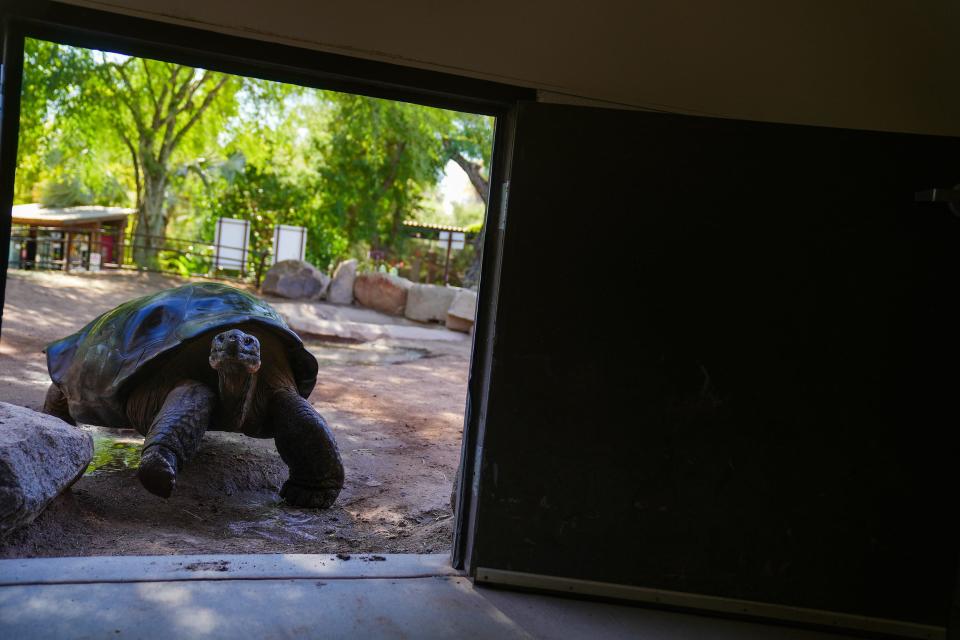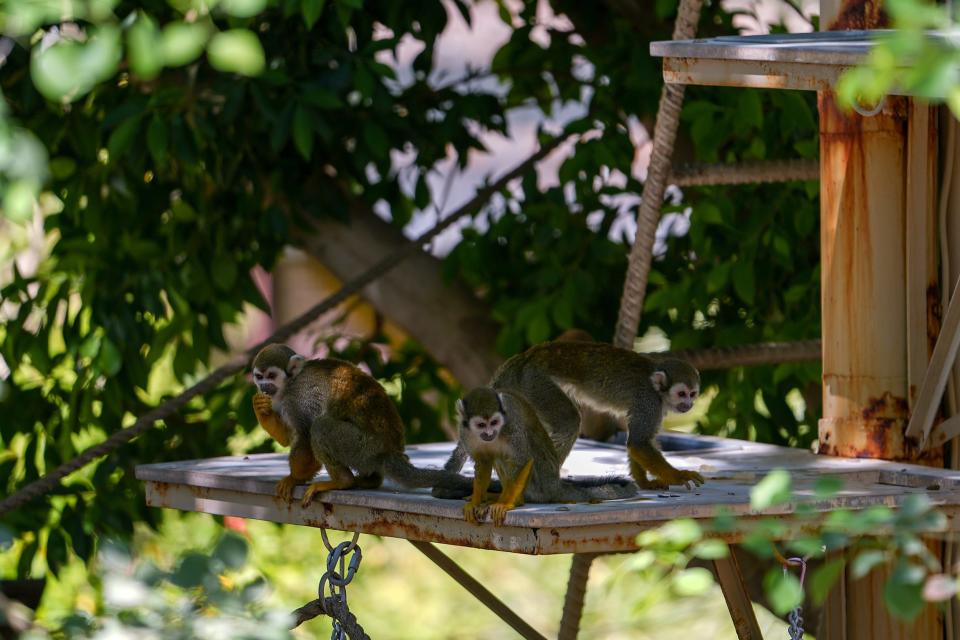Frozen treats, mud baths and Gatorade: How Phoenix zookeepers help animals beat the heat
Temperatures in the Valley have reached extreme highs as summer begins — climbing as high as 114 degrees this past weekend. That means a change in care for animals at the Phoenix Zoo.
Linda Hardwick, vice president of marketing, communications and events, said that while the Phoenix Zoo works to be responsible in choosing animal residents which will thrive in the Arizona heat, some do require special care. In the interest of water conservation, the zoo monitors its consumption and compares it to that of previous years.
But staying cool involves more than water. Keepers at the Phoenix Zoo help their charges stave off the current heat with creative solutions like frozen snacks and water features.
How zoo keepers help animals stay cool
As temperatures hovered around 100 degrees on Tuesday morning at the Phoenix Zoo, the animals were able to escape the sweltering heat with the help of their keepers.
Indu, the Asian elephant, angled her bulk behind a fence post, trying to take advantage of the meager shade it offered. Her keeper, Ryan Tang, took that as a sign to open the garden hose, aiming the spray over her head and across her face.
She closed her eyes in relief, and began siphoning up muddy water from the ground with her curling trunk to toss over her shoulders, a behavior known as "claying" in which elephants cover themselves in mud to create a protective layer from the sun and insects.
The 57-year-old has staunch preferences and won't be enticed into the pool she shares with the zoo's rhino, choosing personal showers instead.
"She's such a princess," laughed keeper Madison Temple.
Dinosaurs: This jaw-dropping dinosaur exhibit is coming soon to Phoenix Zoo. How to get a sneak peek
Besides sessions with the garden hose, Indu has access to an indoor, air-conditioned enclosure and misters on an outdoor shade structure, as well as some evolutionary tricks up her sleeve. Because the skin on elephant ears is so thin, Indu can cool herself down by flapping them, dissipating some of the heat around the blood vessels located there.
On particularly hot days, the zoo's residents are given frozen treats, and Indu's was a mixture of fruit and her favorite treat: Gatorade. She gets 15 gallons of the diluted beverage daily. But, according to Temple, she keeps her caretakers guessing on which flavor she wants that day, and wrong choices earn keepers Gatorade to the face.
Reptiles change diet to beat heat

Reptiles, like galapagos tortoise Elvis, can't eat frozen treats because their inner body temperature is regulated by their outer conditions, keeper Mary Savage said. They're unable to digest frozen food and the snacks will get stuck in their system for longer, possibly causing organ damage.
Instead, they're given fruit that's high in water content like melons, cucumbers and squash more frequently in the summer. Elvis propped himself up on another tortoise when Savage stood close to his side of the pen.
"The prime tortoise motivation is food," she joked.
Later, Savage misted Elvis with the hose, for which he stood up on his tiptoes and stretched his neck out eagerly.
Not everyone at the zoo enjoys water, however. Cheetahs Rhett, Wilkes and Beau prefer to hunker down over their blood popsicles — frozen mixtures of water and blood leftover from their meals.
Initially, the three brothers were unwilling to make the trek down the hill from their spots in the shade. While they're active in the cooler hours of the morning, it's difficult to persuade them to move once the heat sets in, Dawn Addelson, the carnivore collection manager said.
"Carnivores spend the majority of their time resting in the shade," she explained.

Monkeys use cooling pad, misters
The zoo's ten squirrel monkeys aren't fans of swimming, either, so their enclosure is set up with a cooling pad and misters on several climbing platforms.
Summer fun: Splash pads are open across Phoenix. Here are 49 places to cool off your kids this summer
The tiny primates swing through tall, leafy trees that provide ample shade and run along connecting ropes hung with ice-encased raisins. Several hung upsides down from the ropes with their feet, trying to free the chained-up ice treats for themselves.
When all else fails, keeper Danyelle Benza said the monkeys can be found in their cooled indoor enclosure, spread-eagle on the floor.
New animals at Phoenix Zoo adjust
For some newcomers to the zoo, the Arizona heat has been an adjustment. Three-year-old Sumatran tiger Raja was transferred in April from Point Defiance Zoo in Tacoma, Washington, and his tolerance threshold is currently at 95 degrees. That's when he retreats into his air-conditioned enclosure.
Most zoo animals have access to their indoor enclosures, called night houses, once a specific temperature determined by zookeepers based on their species is reached. While Raja is biologically capable of withstanding much higher temperatures, it's a work in progress. He makes ample use of his personal pool in the meantime.
Wgasa is another newcomer experiencing Phoenix temperatures for the first time. The Bornean orangutan moved to the Valley from Omaha, Nebraska, in April and so far is not a fan of the extreme weather.
The zoo has an outdoor area for the orangutans, as well as an air-conditioned day room and underground sleeping areas. Sixteen-year-old Wgasa spends much of the day asleep underneath a blanket in the dayroom, and his companion, 17-year-old Rayma, sits in the corner of the dayroom holding a palm frond up in front of her.
Keepers provide the orangutans with the fronds daily, and the primates like to chew the stalk or use them as cover.
Like reptiles, birds can't eat frozen foods to keep their temperatures down, and so must take advantage of garden showers, which keepers provide up to twice a day when the heat climbs above 100 degrees.
Archimedes, the Eurasian eagle owl, especially loves these hose-downs, turning his head under the spray and fluffing up his feathers afterward. His ear tufts droop slightly under the pressure, giving him a comically melancholy appearance.
All birds in the zoo have shaded enclosures and water bowls large enough to take a dip, which Archimedes does often. Wetting their feet helps them cool down, because the skin of their feet is exposed, while the rest of their bodies is covered in a thick layer of feathers.
The zoo is currently operating on summer hours, from 6 a.m. to 1 p.m., to ensure that visitors and animal residents remain cool and comfortable. Hardwick recommends that visitors carry water and wear light clothing.
"Be careful, just like anytime you're heading out into the Arizona sun," she said.
This article originally appeared on Arizona Republic: How Phoenix zookeepers help animals beat the heat

